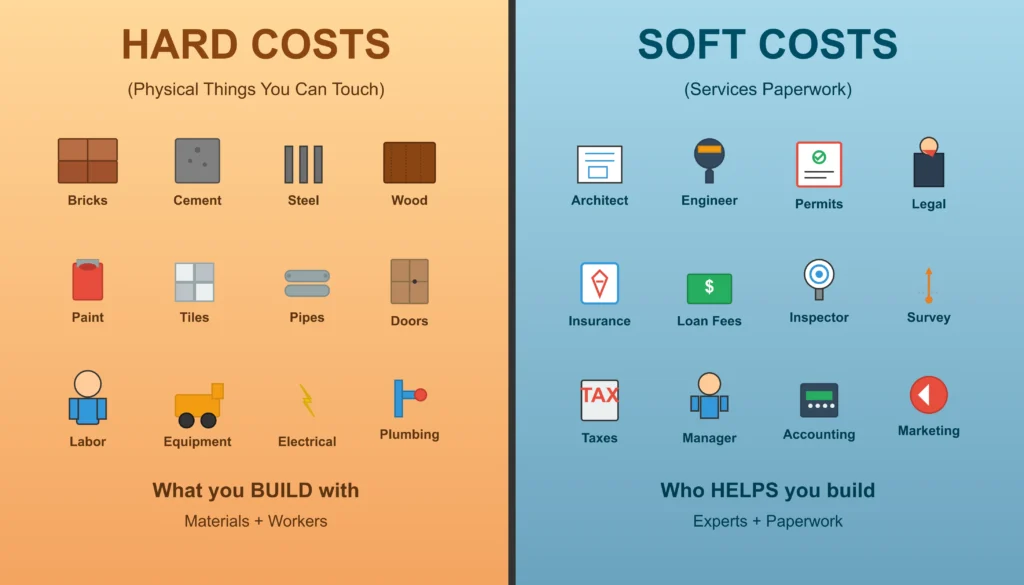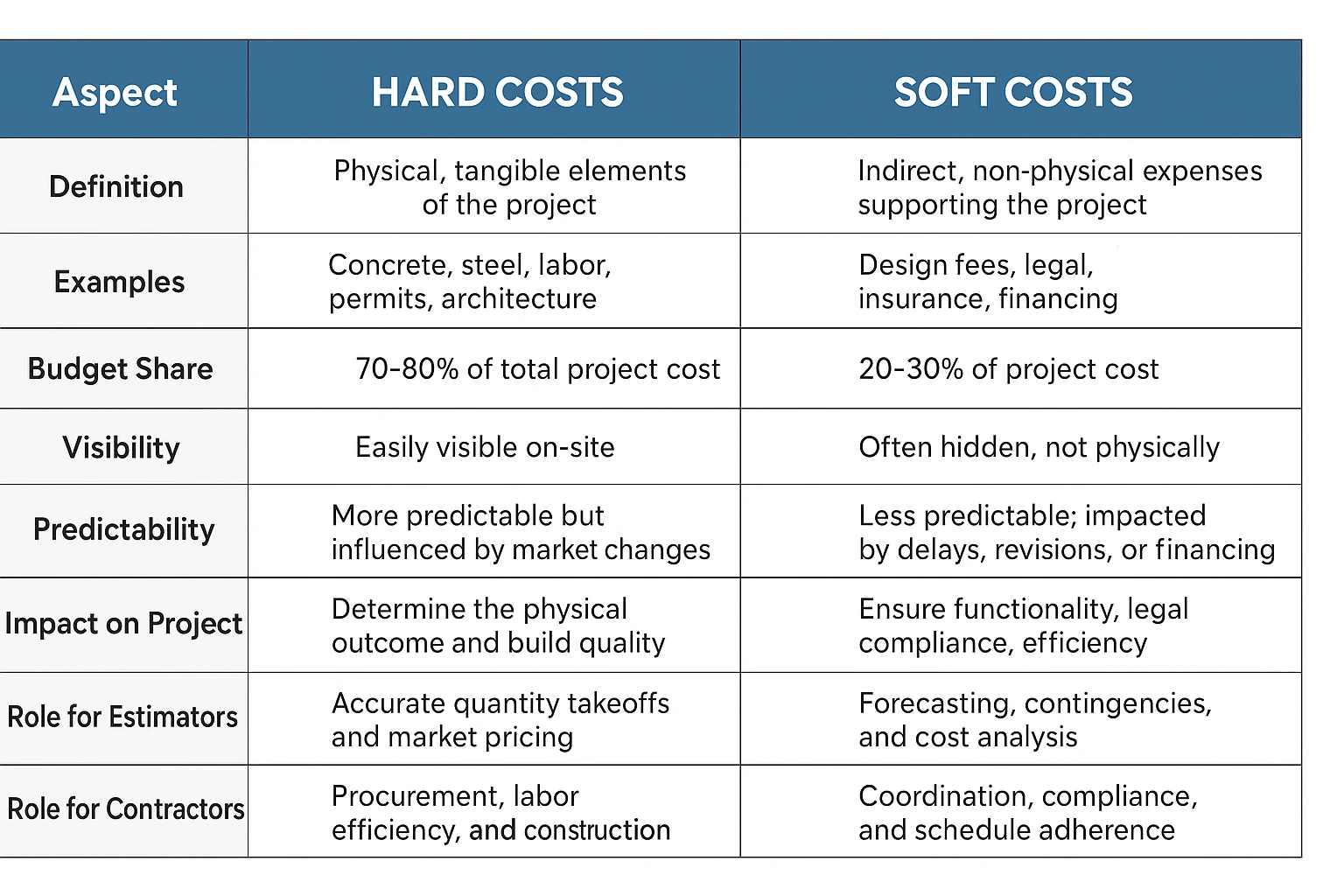Soft vs. Hard Costs in Construction
In construction, every dollar matters. Knowing the difference between soft and hard costs can make or break your project. Misjudging them can delay work, stretch budgets, and hurt your return on investment. When you understand how each cost shapes design, planning, and execution, you make smarter choices, build stronger budgets, and keep your project running smoothly from start to finish.In short, cost clarity means control. And in construction, control is the key to completing projects on time and within budget.
UtopianTakeoffs Construction Estimation Services
At UtopianTakeoffs, we specialize in providing precise construction estimation services that cover both hard and soft costs. From detailed quantity takeoffs and material pricing to permit analysis, design fees, and project management costs, we deliver comprehensive estimates that keep your project on budget and on schedule. Our expert estimators use advanced tools and industry insights to forecast costs accurately, identify potential savings, and support informed decisions—ensuring your construction project is financially efficient from concept to completion.
Table of Contents
Understanding Construction Costs
Every construction project involves two major cost categories—hard costs and soft costs. Hard costs represent the tangible elements that make up your building. While soft costs include services such as design, permits, and management. Knowing the difference helps estimators and contractors budget wisely, track expenses accurately, and keep clients informed. Both are essential, but they impact your project’s timing, risk, and outcomes in very different ways.
Estimators and contractors separate hard and soft costs to manage budgets, track expenses, and keep clients informed. Both are essential, but their timing and impact differ. Understanding this distinction ensures smoother planning, accurate estimates, and fewer surprises throughout the project.
What Are Hard Costs?
Hard costs form the backbone of any construction project—the tangible, physical elements like materials and labor. Typically 70–80% of the total budget, they’re easier to estimate and measure, making them the most visible part of your project’s cost structure.
Examples of Hard Costs
- Materials: Concrete, steel, bricks, lumber, glass, roofing, flooring
- Labor: Wages for workers and subcontractors
- Equipment: Cranes, scaffolding, tools, machinery rentals
- Site Work: Excavation, grading, foundations, paving
- Building Systems: MEP Solution (HVAC, electrical, plumbing)
- Landscaping & Exterior: Driveways, parking, fencing
Hard costs are easy to track since they’re tied to materials and labor, but they can fluctuate due to design changes, inflation, labor shortages, or supply chain delays. Estimators must account for these variables to keep budgets accurate and avoid unexpected cost overruns.
Why Hard Costs Matter for Estimators and Contractors
For estimators, understanding hard costs means accuracy and foresight. They analyze blueprints, perform quantity takeoffs, and use current market rates to forecast expenses, ensuring the budget reflects the project’s true scope.
For contractors, managing hard costs efficiently protects profitability, as delays, design changes, or labor issues can quickly drive up expenses. For owners, hard costs make up most of the financing needs, helping them make informed choices about materials, finishes, and project scope. In short, hard costs define both the physical outcome and the true cost of building a project.
What Are Soft Costs?
While hard costs build the structure, soft costs drive the project behind the scenes. They include design, permits, administration, and financing—essential expenses that are often overlooked because they aren’t visible on-site, yet they play a critical role in keeping the project on schedule and within budget.
Examples of Soft Costs
Soft Costs Include:
- Design & Engineering: Fees for architects, engineers, and consultants
- Permits & Legal: Building permits, zoning, and legal documentation
- Project Management: Overhead, scheduling, and coordination
- Insurance & Taxes: Builder’s risk, liability coverage, property taxes
- Financing & Interest: Loan fees and construction interest costs
- Marketing & Sales Costs: Expenses for advertising, signage, and real estate commissions, essential for promoting and selling commercial or residential projects.
Soft costs usually make up 20–30% of the total project budget and can extend beyond construction, covering items like post-construction maintenance, legal fees, and other administrative expenses during project handover.
The Challenge of Estimating Soft Costs
Soft costs can be unpredictable, with design changes, permit delays, or financing issues quickly increasing expenses. Experienced estimators include contingencies and time-based adjustments to keep budgets realistic.
For contractors, tracking soft costs ensures smooth coordination between design and construction. For owners, understanding these costs helps manage cash flow and avoid financial surprises at project closeout.
How Both Cost Types Shape Accurate Estimation
A project estimate goes beyond adding numbers—it’s about understanding how hard and soft costs behave throughout the project. Ignoring either can cause underbudgeting and miscommunication.
For example, a stunning design may appear affordable based on materials and labor, but unaccounted soft costs like design changes, permits, or legal fees can quickly inflate the budget. Similarly, ignoring potential hard cost fluctuations, such as material price hikes or labor shortages, can create major gaps between estimated and actual project costs.
Successful estimation isn’t just about numbers—it’s about foresight. Balancing hard and soft costs helps teams make realistic decisions on scope, design, and project delivery, keeping budgets and timelines on track.

Impact on Design and Decision-Making
Understanding hard and soft costs is key to smart construction planning. Design isn’t just about looks—it’s balancing functionality, aesthetics, and budget. Both cost types directly shape design choices and overall project feasibility.
When owners and design teams understand hard and soft costs, they can make smarter trade-offs early. Choosing expensive materials may limit funds for design or engineering services, while extended design revisions can quickly raise soft costs like architectural fees and permits—sometimes before construction even starts. Balancing both ensures the project stays on budget without compromising quality or functionality.
Balancing Design Aspirations with Budget Reality
During conceptual and schematic design, estimators and contractors turn design ideas into cost data, showing architects and owners how choices affect the budget. Accurate estimates include both hard and soft costs, allowing teams to test “what-if” scenarios and make informed decisions before finalizing the design.
For instance, an energy-efficient HVAC may raise initial hard costs but reduce long-term expenses, affecting both cost types. This highlights the importance of value engineering to balance upfront investment with overall project savings.
The Role of Value Engineering
Value Engineering (VE) isn’t about cutting corners—it’s about maximizing performance and value. By analyzing each project component, teams identify cost-effective alternatives that meet design intent without compromising quality or safety.
For estimators, VE enables intelligent cost reallocation. For contractors, it ensures efficient construction and schedule adherence. For owners, it aligns design ambition with budget to maximize ROI.
VE allows adjustments to both hard and soft costs, from selecting less expensive materials and simplifying construction methods to optimizing design services. This approach saves time, reduces expenses, and keeps the project balanced, efficient, and financially sound.
Strategies to Control Both Soft and Hard Costs
In construction, controlling hard and soft costs is essential. Collaboration between estimators, contractors, and owners from day one ensures efficiency and budget success.
Start with Early Cost Planning
Beginning cost planning early is key. Pre-design estimates that include hard and soft costs give owners and teams a realistic financial framework, helping prevent “scope creep.” Early collaboration between estimators, architects, and owners allows adjustments before designs progress too far. Estimators should update cost models continuously to reflect changes in materials, labor, and service fees.
Maintain Transparent Communication
Effective cost management relies on transparency. Estimators must clearly separate soft and hard costs in reports and regularly share updates with owners and contractors. Open communication ensures everyone understands fund allocation, identifies potential overruns early, and keeps the project on budget and on schedule.
Use Technology and Data Analytics
Modern tools like BIM and construction estimation software have revolutionized cost tracking. BIM visualizes how design changes affect materials and services in real time, while estimating software integrates historical data, supplier prices, and regional trends. Linking design and cost data allows estimators to forecast accurately and spot savings early, giving owners and contractors a data-driven basis for decisions.
Include Contingencies and Inflation Allowances
Even precise estimates need room for the unexpected. Market shifts, delays, or regulatory changes can impact hard and soft costs. Adding contingencies—5–10% for construction, 3–5% for soft costs—absorbs unforeseen expenses and keeps the project on track.
Monitor Costs Continuously
Cost control continues through construction. Regular cost-to-complete reports reveal gaps between projected and actual spending. Contractors track procurement and labor efficiency, while owners review invoices and change orders with estimators to prevent overruns.
Optimize Design-Build Collaboration
Using IPD or design-build fosters seamless coordination between design and construction teams. This approach minimizes conflicts, cuts redesign costs, and speeds decision-making, ensuring both hard and soft costs are managed efficiently and the project stays on schedule and budget.
The Estimator’s Role in Cost Integration
The estimator bridges design and execution, turning vision into financial reality. They analyze and interpret the relationship between hard and soft costs, providing detailed breakdowns, cash flow forecasts, and value analyses. This empowers contractors and owners to make informed decisions.
Top estimators treat cost management as an ongoing process of prediction, evaluation, and adjustment, ensuring projects remain viable, on budget, and aligned with both design intent and financial goals throughout the construction lifecycle.
Conclusion–Soft vs. Hard Costs in Construction
In construction, success starts with clarity, and that begins by understanding hard and soft costs. Hard costs shape the physical project, while soft costs ensure functionality, legality, and efficiency.
For estimators, this builds trust and accuracy. For contractors, it improves execution control. For owners, it supports informed design and investment decisions.
A balanced cost strategy isn’t just about saving money—it ensures the project performs, lasts, and delivers value. Managing both cost types together turns a building into a successful, well-planned construction project.

